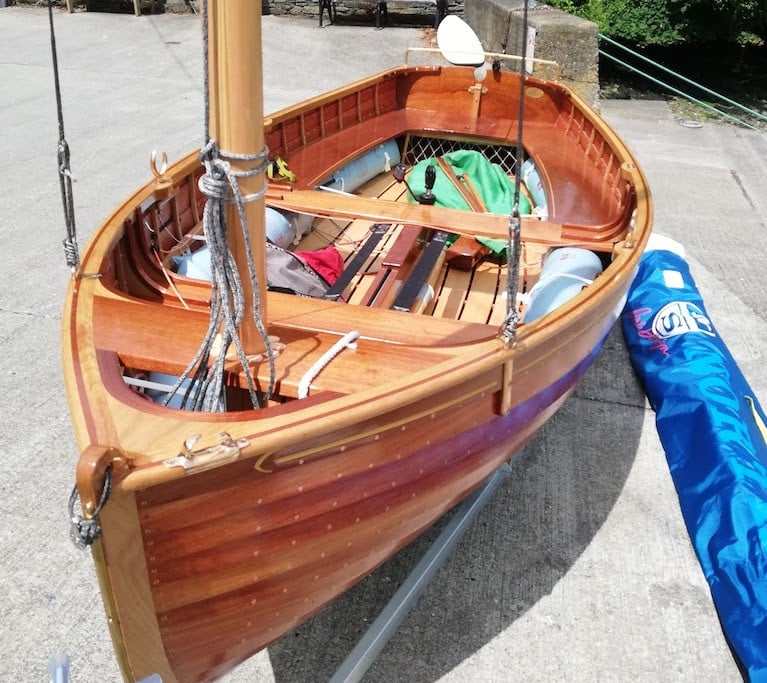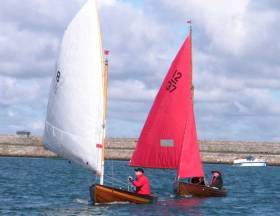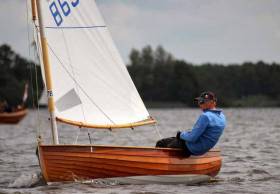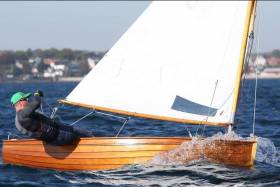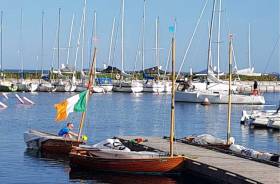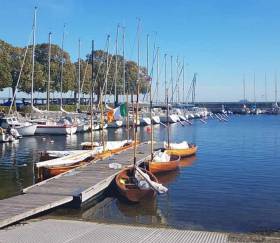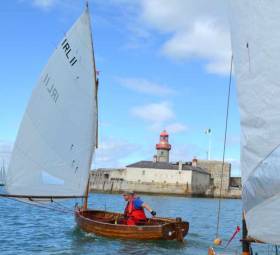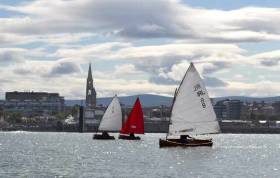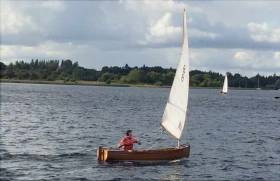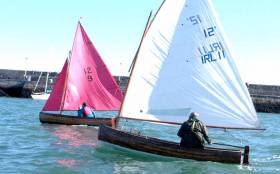Displaying items by tag: International 12 foot Dinghy
International 12 Dinghies To Celebrate New Arrival at Revived Royal St.George Yacht Club Championships
As the International 12-foot class prepares to celebrate the tenth anniversary of its revived championships next week in Dun Laoghaire Harbour, the historic dinghy class is also welcoming a new arrival.
A new clinker-built 12 has recently been completed by Rui Ferreira of Ballydehob in West Cork.
This class was designed in 1913 by George Cockshott as the British Racing Association 'A' Class. The class was adopted by the International Yacht Racing Union on 1st. January 1920 and thus it became the International 12 Foot Class. The class was the only dinghy class to compete at the 1920 Antwerp (Belgium) Olympic Games, at Oostende.
 The new build 12 on the slipway in West Cork
The new build 12 on the slipway in West Cork
As Afloat previously reported, the class grew in popularity in Ireland in the 1920s and 1930s with fleets of professionally and amateur-built boats in Baltimore, Clontarf, Crosshaven, Howth, Malahide, Sutton, and Seapoint (Monkstown, Co. Dublin).
Today there are many 12 Foot Dinghies in Ireland, some having been in the same families for many years. Some are unused and located in barns while others are used as yacht tenders. We have a member interested in restoring an International 12 Foot Dinghy, so if you have one which needs restoration, do let us know.
In 2010 Gail Varian organized a revived Irish Championship at the Royal St George Yacht Club.
The 10th anniversary of this revived championship for the historic 12 Foot Dinghy prizes will be held in Royal St George Yacht Club, Dun Laoghaire on Sunday 13th September, in which the modified Dublin Bay 12 Foot Dinghies with a mainsail and jib will sail against the International 12 foot Dinghies with just a mainsail on equal terms.
A small piece of yachting history: At the 1920 Olympic Games at Oostende, the organisers didn't know the difference between a 12 Foot Dinghy and a 12 Meter Yacht, so they put both classes on the same course. After one race, the dinghy competitors went on strike and refused to race on the 25mile long racecourse. This caused such chaos among the organizing committee, that it was several months later before the second Olympic race for dinghies which was held in a different country, in The Netherlands.
The organisers would like to hear from any Irish owners of 12 Footers.
For more information contact the author below
Historic Prizes at Royal St George Yacht Club on Offer for 12 Foot Dinghies
This 12-foot class was designed in 1913 by George Cockshott, an English yacht designer, as the British Racing Association ‘A’ Class. The class was adopted by the International Yacht Racing Union on 1st. January 1920 and thus it became the International 12 Foot Class. The class was the only dinghy class to compete at the 1920 Antwerp (Belgium) Olympic Games, at Oostende. This event will be celebrated in 2020 with a re-enactment regatta on 11-12 July with entries expected from Holland, Turkey, France, England, Uganda and Ireland.
The class grew in popularity in Ireland in the 1920s and 1930s with fleets of professionally and amateur-built boats in Baltimore, Crosshaven, Howth, Sutton, Clontarf and Seapoint (Monkstown, Co. Dublin).
What is the international 12 Foot like? She is a traditional wooden clinker-built one-design with a single standing lugsail, hung off a mast located near the bow. The 3.66m x 1.43m. hull is open decked and is spacious enough for either single-handed sailing or a crew of two.
Today, many 12 Foot Dinghies still exist in Ireland, having been in the same families for many years. Some are unused and located in barns while others are used as yacht tenders.
In July this year, a Friendship Regatta was held on Rutland Water, which was well supported by Irish, English Dutch and Ugandan boats.
An Irish championship for historic prizes will be held in Royal St George Yacht Club, Dun Laoghaire on Sunday 15th September in which the modified Dublin Bay boats with a mainsail and jib will sail against the International 12 foot Dinghies on equal terms. The organizers would like to hear from any Irish owners of 12 Footers. In 2020 the12 foot Dinghies will compete at CLINKERFEST the 250 anniversary of Lough Ree Yacht Club on the June bank holiday weekend.
For more information contact [email protected]
Vintage Yachting Games Conclude in Copenhagen
Unfortunately, the weather in Hellerup, near Copenhagen for the past two days has not been suitable for racing in small dinghies. However, event PRO Peter Stephensen Lubeck (DEN) was wise enough to predict this scenario, and doubled up the number of races on Thursday, and in so doing he achieved 6 good races of 8 race series for the 12 Foot Dinghies.
As predicted by some 12 Foot Dinghy buffs, one or other of the two Bleeker brothers from Holland was likely to rise to the top of this event which takes place every four years.
After six good races, it was Wim Bleeker (who was Dutch 12 Foot Dinghy champion of 2013, 2015, 2016 and 2017) who won the Vintage Yachting Games 2018, in the largest class competing.
The other classes competing in this year’s Vintage Yachting Games were the Soling and O-Jolle or Olympiajolle which was a single–hander used for the 1936 Olympic games in Kiel, and still popular in Germany and Holland.
The venue for the games in four year’s time has yet to be decided.
For final results download Xcel sheet below:
Delany in Top Ten at Vintage Yachting World Cup
Royal St. George's Mark Delany is in eighth place at the Vintage Yachting Games in Copenhagen while clubmate George Miller in 11th overall.
Four races were held for the 12 Foot Dinghy Class on Thursday, because there is a large storm heading towards Copenhagen, which may create unsailable conditions for small boats.
Having won all of the races except for his discarded race, Wim Bleeker from Holland has shown his complete superiority over the rest of the fleet.
Behind Wim, the leaderboard has been given a huge reshuffle, partly as a result of the discarded race kicking in. Sipke Schuurmans overall position has risen from 12th to 4th place, and Jaap van Hasselt has dropped from 5th to 12th, but despite that, the Dutch are still maintaining a stranglehold on the top seven places.
A significant issue yesterday was the wind which was very strong when the dinghies launched this morning, as a result of which some helmsmen did not like the conditions, and in the interests of safety, they returned to port. However, for the others who persisted, on reaching the race area off Skovshoved Havn. about 4km from their base the wind direction changed, and the wind dropped progressively to a gentle 5-8 kts. Thus, some boats only competed in the afternoon races.
The PRO does not expect that it will be possible to race today.
For full results:
Royal St. George's George Miller Moves Up to Sixth at Vintage Yachting Games
Dublin Bay's George Miller moved up to sixth and Mark Delany is tenth but yesterday saw many 12 foot dinghies retiring from the racing at the Vintage Yachting Games due to the weather conditions off Hellerup in Denmark.
The dinghies shipped a lot of water as can be seen in our picture (above). Only 10 boats finished from the fleet of 19.
Rifat Edin received a black flag disqualification.
Ed van Cortenberghe did not compete.
Results downloadable below.
George Miller's 'Pixie' Lying Ninth at Vintage Yachting Games
Royal St. George's George Miller is lying ninth overall at the vintage yachting Games in Copenhagen while Mark Delany is 12th after one race sailed.
It must be remembered that when the International 12–foot dinghies competed in the Olympic Games in 1920, they raced off Ostend on a huge course more suited to the 12 metre and 6 metre yachts. The wind and tide conditions were such that the event could not be completed within the allocated time. In those days all the 12 footers raced with a crew of two.
Today at the Royal Danish Yacht Club and Hellerup Sailing Club, the 19 competitors could decide if they would sail with a crew of one or two crew.
In race one, on 18th September the wind was blowing about 22 knots in strong sunshine and flat water, and the racing was dominated by the experienced Dutch teams.
The racing was interesting as the boats which had two crew performed better upwind, while the single-handed boats did best downwind.
Download full results below
Ireland Competes in Vintage Yachting Games 2018 in Copenhagen
The fourth edition of the Vintage Yachting Games takes place in Copenhagen from 16-22 September 2018.
The Vintage Yachting Games provide an opportunity for a high-level international regatta for the classes which were once Olympic Games equipment or Paralympic Games equipment and are no longer used in those games.
The Vintage Yachting Games were founded by Rudy den Outer, Nancy Schoof and Sebastian Hopf. The previous Vintage Yachting Regattas were 2008 Medemblik (NED), 2012 Lake Como (ITA), 2016 Weymouth (GBR).
The classes eligible to sail include the Europe Dinghy, 12 Foot Dinghy (wood), 2.4meter, O-Jolle, 12m2 sharpie, Flying Dutchman, Yngling, Star, Soling, Dragon, 5.5 meter and 6 meter.
Of these classes, the highest number of entries in 2018 came from the 12-foot class with twenty entries from seven countries.
This class was raced in Ostend and Amsterdam in the 1920 Olympic Games and in Amsterdam in 1928. It was selected as it was the only dinghy class with international status. The 2018 regatta is hosted jointly by the Kongelig Dansk Yachtklub (Royal Danish Yacht Club) and the Hellerup Sejlklub (Hellerup Sailing Club).
There is one UK entry, 12 foot dinghy No.60 entered by Doug Branson, and two Irish entries, No. 8 Cora sailed by Mark Delany from Lough Ree Yacht Club, and No. 11 Pixie sailed by George and Andrew Miller from the Royal St. George Yacht Club.
Miller was the recent winner of the Irish Championships sailed in early September in Dun Laoghaire, with Delany as runner-up.
George Miller's 'Pixie' Wins International 12 Irish Championships
The term ‘vintage’ is rarely used in respect of racing dinghies, however, in 1920 the Olympic Federation were felt that a suitable dinghy should be used in addition to the 40m.2, 30m.2, 15m., 12m., 10m., 8m., 7m., and 6m. keelboat classes. The International 12-foot dinghy was selected.
This class is still active in Ireland, in two forms, the original single sail rig, and the later Dublin Bay Sailing Club innovation of moving the mast aft and providing a jib, but with no increase in total sail area. The Royal St. George Yacht Club organised the fifth Irish Championship of recent years, on 2nd September 2018. Entries came from far and wide including one UK entry, one dinghy from Clew Bay and one from Lough Ree. Four races were held in Dun Laoghaire Harbour, two in the morning and two in the afternoon.
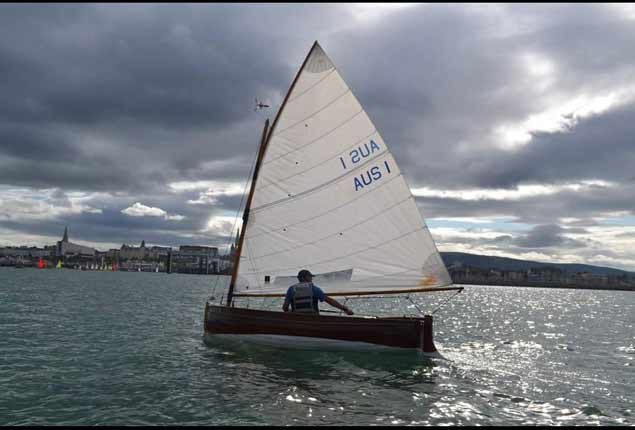 Andrew Johnston in Scythian
Andrew Johnston in Scythian
Race one was held in 6-knots and George Miller in ‘Pixie’ led from beginning to the end of two laps of the triangular course, with ‘Scythian’ second, and ‘Cora’ third. For race two the wind had increased to 10 knots, and Gavan Johnson in ‘Albany’ led initially, to be passed by Mark Delany in ‘Cora’ who took the gun. In this race ‘Scythian’ had a difficulty with her rig, and in solving that problem, she created another by capsizing! A leisurely lunch was held in the clubhouse, at which point last year’s winner ‘Cora’ held a small lead in the overall standings. George Miller in ‘Pixie’ won race three from ‘Scythian’ in an unstable light wind, and in the final race Andrew Johnston’s ‘Scythian’ took an early lead and won from ‘Pixie’.
For full results download below:
Historic 12–foot Dinghy Class To Hold Championships at the Royal St George Yacht Club
The historic 12-foot class will hold its fourth championship of recent years in Dun Laoghaire for both International 12 foot Dinghies and Dublin Bay Sailing Club 12 footers.
Racing will take place in Dun Laoghaire hosted by the Royal St George Yacht Club on Sunday 26th August.
The 12 foot class has a long history in Ireland. they were designed in 1913 by George Cockshott, The class in Ireland arrived in 1923 when 15 boats were built by James Pluck of Cobh.
The first face was at the Cork Harbour Motor Boat Club on the day when the clubhouse was opened. (now the Royal Cork Yacht Club).
Fleets developed in Kinsale, Seapoint (Dublin), Howth, Sutton, Kilbarrack, Malahide, Clontarf, and Baltimore.
For more information, contact Vincent Delany at 0868575374.
CORK 300 Gets Vote of Historic 12 Foot Dinghy Class AGM
A huge group of over thirty 12 Foot Dinghy enthusiasts turned up at the Royal St. George Yacht Club on 6th April for the 94th AGM of the ‘Irish International 12 foot Dinghy Class’ or ‘Cumann Báid Dhá Chosa Déag na hÉireann.’
There were representatives from Belgium, Uganda, Baltimore, Cork, Cavan and Dublin Bay (north and south). The members heard a summary of last years escapades, including trips taken by some of the Irish 12 foot dinghies to European and ‘Brexit’ events, and the Irish Championship won by Mark Delany in Cora. A book describing the Class activities in Ireland since 1923 was launched.
"A book describing the Class activities in Ireland since 1923 was launched"
During the 2018 season there are many exciting events proposed, including the highlight of the year which is:
The third Vintage Yachting Games organised by The Vintage Yachting Games Organisation, The Royal Danish Yacht Club, and Hellerup Sailing Club on 15-22 September-2018, sailing on the waters Oeresund, east of Skovshoved and Hellerup Harbors just north of Copenhagen, Denmark.
The Vintage Yachting Games Organisation is a non-commercial joint venture of the following former classes which have competed in Olympic Games since 1920. (Vintage Yachting Classes): Europe, International 12, Olympiajol, Flying Dutchman, Yngling, Soling, Dragon, 5.5 Metre, 6 Metre, 2.4 Metre and Star.
According to the rules “The International 12 will race with wooden clinker built according to the original design, and shaped, rigged and fitted accordingly. Vintage dinghies will generally be accepted, round wood should be solid, sails should be fixed to boom and lug such that no profitable in-race adjustment is possible. There should be no gear for profitable in-race adjustability of the mast foot. A boom marline is allowed but not required.”
We are quietly confident of having two Irish entries competing at these games, they are No. 8 and No.11. These numbers are highly significant as other countries will have boats carrying numbers up to 850.
The Class have decided to hold their Irish championship in the Royal St. George yacht Club at the end of August.
The 12 foot class have also decided to compete at CORK 300 in the year 2020 at Royal Cork Yacht Club as a demonstration fleet in the Currabinny River.
The 12 foot class have decided to write to the 12m. Class, looking for twinning of the classes.
Vincent Delany.
Committee Member.



























